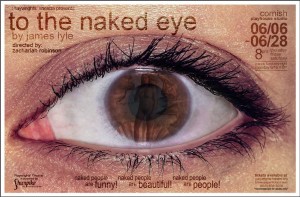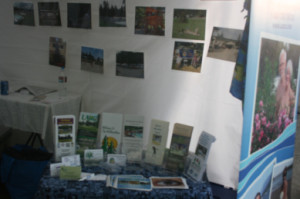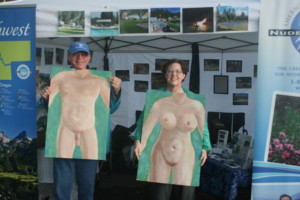by Mel Kanner
Number 7 in a series of articles examining the changes that I have observed to the practice of nudism over the years and our society’s view of nudity.
Archive: #1, #2, #3, #4, #5, #6, #7
————————————————————————
Clothing
We, as nudists, go without clothing when we can. Which when you stop and think about it, is very strange. With a few minor exceptions, all seven billion of us on this planet, live in a culture in which clothing is the norm, and is required.
In order to understand what we get from shedding our clothes, perhaps it would be valuable to look at some of the ways we use clothes in our society. And what that says about us.
Obviously, the primary use of clothing is for protection from the weather or from hazards. It is either too cold, or there is too much sun. As nudists we know that it is not a good idea to be nude while frying bacon or welding.
Our “need” for clothing goes beyond just protection. It is ingrained into our culture, our way of life. It contributes a significant amount to our economy and the vocabularies of our languages. Coats, hats, gloves, parkas, boots, sweaters, socks, stockings, vests, pants, jackets, shoes, etc. etc. When learning a foreign language, after learning how to count from one to ten, and the colors, you work on words for clothing. (The hat, le chapeau).
We use clothing to distinguish between different groups: our tribe from that other tribe (we wear blue feathers, they wear red feathers); our religion from that other religion (we wear skull caps, they wear turbans); our leader from the rest of us (s/he wears a crown, we don’t); our country from that other country (we wear lederhosen, they wear kilts).
We use clothing to distinguish between the sexes. In general, males wear pants, females wear skirts. There are exceptions, of course, and some variations in different cultures. We have particular customs, styles, ways of dressing that are different for men and women. On women’s jackets the buttons are on the left and the button holes on the right. For men it’s the reverse.
Over the centuries these styles have changed — the rules about the type of clothing permitted to be worn by the sexes have changed. Now, in our western culture women are allowed to wear pants, but men are not allowed to wear skirts (except for kilts) or dresses. Men wearing women’s clothing is a form of humor. We even have different styles of bicycles for men and women to accommodate the differences in clothing.
We use clothing to distinguish people by their function or occupation. Military uniforms are instantly recognizable. As are uniforms for police, nurses, judges, clergy. And for the employees at McDonalds and at my local big box hardware store.
We use clothing to distinguish a person’s class or status — where they are in the social order and how much money they have. In previous more class-ridden societies, such as in England during the Downton Abbey days, there were different standards of dress for each of the classes. In current North American society this is not as distinct, but it is still there. We still have white collar, blue collar.
Before I retired, I would often have to meet with customers in professional establishments. Slacks, dress shirt, and tie were considered the minimum acceptable attire. This was particularly true on the east coast. On the west coast, the tie was not necessary. Full “business” attire (for men) — suit, dress shirt, tie, dress shoes — is usually only worn by politicians, lawyers, and preachers (in the South).
(In the last couple of decades, a sort of reverse dress code emerged. Geeks developed a style of less formality, and a visiting geek (like me) who wore a tie, lost some credibility, even on the east coast. The CEO of Apple when presenting the latest and greatest Apple products does not wear a suit and tie.)
Notice that when I mentioned “dress shoes”, you knew what I meant. We have standards of formality of dress that is part of our culture. Clothing for different occasions — weddings, funerals, church, proms. Clothing for different activities — gardening, tennis, jogging. White tie, black tie, dressy, casual. We have standards as to what clothing can be worn for each occasion. Don’t be under-dressed, don’t be over-dressed. As we grow up, we are taught the appropriate “rules” for these different types of dressing. For example, look at the ads in advance of Easter to see what little girls and little boys are expected to wear.
We have standards as to what clothing can be worn with other clothing — one doesn’t wear a striped jacket with checkered pants. Some colors don’t go well with other colors. Except when it was a fad, men didn’t wear pink shoelaces. In general, even now, men don’t wear pink (except in a tie, sometimes).
I can’t speak for women here. Their clothing requirements are much more complicated. And what can and can’t go together is beyond me.
We use clothing to carry things. Pockets are very functional. Most men, for most occasions, can carry all of what they need without some sort of external purse or satchel. At least that is the way it used to be. Now with all the extra smart phones, tablets, etc. many men (including me) carry some sort of external bag. It is still not appropriate to call it a purse, but …
We use clothing for adornment, for decoration — a ribbon in the hair, a flower in a lapel, a scarf to add some color, a piece of jewelry — rings (fingers, toes, ears), watches, earrings, cuff links, tie clasps, lapel pins. A man’s tie has no other function.
I have not exhausted the list of the ways we use clothing. Stay tuned.
Related Images:



